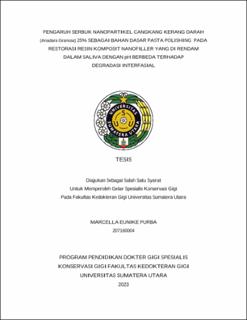| dc.description.abstract | Introduction : Degradation is a phenomenon that can occur in composite resin restorations within the oral cavity. The degradation of the interfacial surfaces of composite resin restorations leads to the occurrence of secondary caries and subsequent failure of the restoration. The achievement of a morphologically anatomically accurate and smooth repair surface, characterized by high gloss polishing, is closely associated with the prevention of degradation. Consequently, it is imperative to employ appropriate polishing techniques to ensure optimal outcomes. The shell of the blood clam (CKD) is composed of around 98% calcium carbonate. This high concentration of calcium carbonate makes it suitable for use as an abrasive and remineralizing agent in composite resin polishing paste. The objective of this study was to investigate the impact of a 25% CKD nanoparticle powder polishing paste on the deterioration of the interfacial surface of nanofiller composite resin restorations under simulated pH fluctuations in the oral environment.
Materials and methods : The research included a total of 24 mandibular premolar teeth samples that had been treated with Class 1 nanofiller composite resin. These samples were then divided into six distinct groups, denoted as A, B, C, D, E, and F. The first three groups (A, B, and C) were subjected to polishing using a 25% CKD polishing paste, while the remaining three groups (D, E, and F) were polished using a commercial polishing paste. The experimental procedure involved subjecting groups A and D to immersion in fake saliva with a pH of 3, groups B and E to immersion in artificial saliva with a pH of 7, and groups C and F to immersion in artificial saliva with a pH of 10.
Result : Subsequently, an investigation was conducted on the phenomenon of interfacial degradation utilizing Confocal Laser Scanning Microscopy apparatus, with the resulting data being analyzed and interpreted through the use of image-J software. The collected data underwent a One-way ANOVA statistical test, followed by a Post Hoc LSD test. The results of these tests revealed substantial variations in interfacial deterioration among the different treatment groups.
Conclusion : The study's findings indicate that the group subjected to blood clam shell polishing paste shown a capacity to mitigate degradation following treatment with oral pH simulation. The aforementioned capability is anticipated to mitigate the development of secondary caries, hence reducing the likelihood of restoration failure. | en_US |


